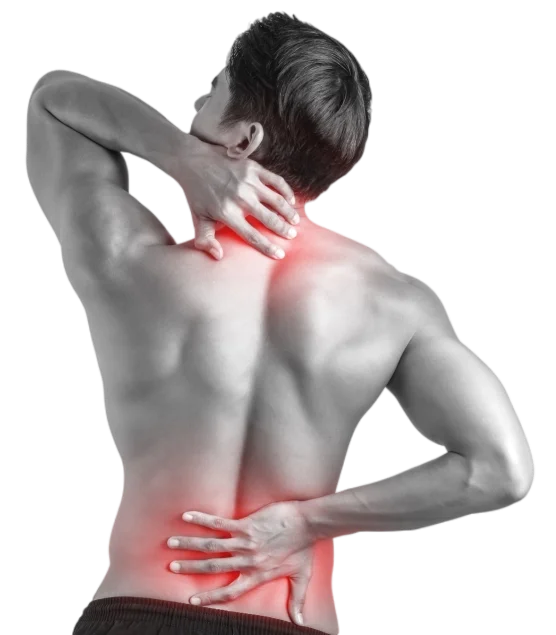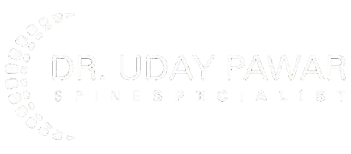Scoliosis Treatment
in Mumbai
Scoliosis is a condition that causes the spine to curve sideways. It can affect people of all ages but is most commonly diagnosed in childhood and adolescence. While scoliosis can cause concern, effective treatment options are available.
This article explores scoliosis treatment in Mumbai, focusing on the expertise of Dr. Uday Pawar, a leading scoliosis specialist in the city.

What is Scoliosis?
As we all know, our spine is straight. But sometimes, it bends and forms a curve, different from the body’s natural front-to-back curve. Medically, this curved shape of the spine is known as scoliosis. It can affect people of all ages but is most commonly diagnosed in childhood and adolescence.
If untreated, it can lead to back pain and other postural problems. It is mostly treated with physical therapy, but in rare cases, surgery is advised.

What are the Symptoms of Scoliosis?
As a scoliosis specialist in Mumbai, when patients come to me, and I diagnose them, I notice that they say, ‘We never felt any symptoms’. I agree. Symptoms of scoliosis are not always visible. Here are some common symptoms of scoliosis.
- Back pain
- Difficulty standing upright
- Core muscle weakness
- Pain, numbness, or weakness in the legs
What are the Signs of Scoliosis?
Signs are something we, as medical practitioners, notice, whereas symptoms are noted by a patient. Here are notable signs of scoliosis.
- Uneven shoulders
- Shoulder blades that stick out
- Head that doesn’t center above your pelvis
- Uneven waist
- Elevated hips
- Constant leaning to one side
- Uneven leg length
- Changes in skin appearance or texture on your back
- Uneven alignment of your pelvis and hips.
What Causes Scoliosis?
The cause of scoliosis varies depending on the type. Broadly following are the causes of scoliosis.
- Vertebrae malformation during embryonic development.
- A genetic change.
- A spine injury.
- A tumor on your spine.
- A condition that affects your nerves or muscles.
How Many Types of Scoliosis Are There?
Scoliosis is typically classified into several types based on the age at which the condition develops, the cause, and the pattern of the spinal curvature. Here are the main types of scoliosis:

Idiopathic Scoliosis
This is the most common type, and its cause is unknown. Idiopathic scoliosis is further divided based on the age of onset:
- Infantile Idiopathic Scoliosis: Occurs in children aged 0-3 years.
- Juvenile Idiopathic Scoliosis: Affects children aged 4-10 years.
- Adolescent Idiopathic Scoliosis: Develops in children aged 11-18 years and is the most common form, especially during the growth spurts of puberty.
Congenital Scoliosis
Caused by a spinal deformity present at birth, resulting from improperly formed vertebrae during fetal development.
Neuromuscular Scoliosis
It is associated with neurological or muscular diseases, such as cerebral palsy, muscular dystrophy, or spina bifida, that affect the muscles that support the spine.
Degenerative Scoliosis
This condition develops later in life due to the degeneration of the spinal discs and joints. It is common in adults and can be exacerbated by osteoporosis and arthritis.
Syndromic Scoliosis
It occurs as part of various syndromes that affect multiple body systems, such as Marfan Syndrome, Rett Syndrome, or Ehlers-Danlos Syndrome.
Secondary Scoliosis
This type develops as a secondary symptom of another condition or due to external factors such as a difference in leg length or injuries.
Understanding the specific type of scoliosis helps tailor the treatment plan effectively, as each type may require a different approach based on the underlying cause and severity of the spinal curvature.
How is Scoliosis Diagnosed?
At Dr. Uday’s Spine Clinic, we conduct various tests to diagnose scoliosis.
X-rays
MRI Scan
CT Scan
Physical examination of spine, ribs, hips, and shoulders
Blood Tests
Using ‘inclinometer’ to measure the degree of scoliosis
How is scoliosis measured?
We use an inclinometer to measure the degree of scoliosis. Don’t worry; it is a noninvasive test. It is similar to the protractor school children use to measure the angle.
We rate the severity of scoliosis based on the degree of the curve:
- No scoliosis inclinometer: Less than 10 degrees.
- Mild scoliosis: Between 10 to 24 degrees.
- Moderate scoliosis: Between 25 to 39 degrees.
- Severe scoliosis: More than 40 degrees.
Who is at Risk of Scoliosis?
According to various studies, scoliosis is genetic. That means if your ancestors had scoliosis, your chances of getting it increase. The second biggest risk factor for scoliosis is injury to the spine, muscles, and nerves.
What are the Treatment Options For Scoliosis in Mumbai, at Dr. Uday’s Clinic?
The type of treatment depends on various factors:
- The type of scoliosis.
- The degree of the curve.
- Your family history of scoliosis.
- Your age.
- The number of remaining growth years until skeletal maturity.
However, as a scoliosis specialist in Mumbai, I don’t recommend treatment options to people unless it is very much necessary and hampering their lives.
Broadly there are two types of treatments for scoliosis.
- Non-surgical
- Surgical
Non-surgical treatments consist of:
- Wearing back braces to support the spine
- Taking pain relieving medicine
- Exercises to strengthen the spine

- Surgical Options
Surgery for scoliosis is done in extreme cases to restore your balance and relieve pressure on your nerves. The different techniques used to perform scoliosis treatment in Mumbai are as under:
Spinal Fusion
This technique involves fusing bones of the spine together with metal braces.
Vertebral Body Tethering
In this procedure, small incisions are made, and screws are placed outside the edge of the spinal curve. Then a strong cord is threaded through the screws, and when the cord is tightened, it makes the spine straight.
Inserting Expandable Rod
If a child has scoliosis, we fit an expandable rod in the spine to support the child’s growing spine.
How to Prevent Scoliosis?
While there’s no guaranteed way to prevent scoliosis because the exact causes for most cases (idiopathic scoliosis) are unknown, here are some approaches that may help reduce the risk or manage its progression:
Early Detection
Regular checkups during childhood can allow for early detection of scoliosis. Early intervention can be crucial in managing the condition.
Maintaining Good Posture
Proper posture reduces strain on the spine and may help prevent worsening of existing curves. Focus on standing tall with shoulders back and core engaged.
Strengthening Core Muscles
Strong core muscles provide better support for the spine. Exercises targeting abdominal and back muscles can improve overall stability and potentially minimize the impact of scoliosis.
Physical Therapy
A physical therapist can design a personalized exercise program to strengthen core muscles, improve flexibility, and potentially help manage the curvature of the spine in some cases.
Bracing
For adolescents with mild to moderate curvatures, wearing a brace as a doctor prescribes may help prevent further progression.
- Here's what to keep in mind
Focus on Management
While complete prevention might not be possible, early detection and management strategies can significantly influence the course of scoliosis.
Consult a Healthcare Professional
Consulting a doctor or a physical therapist specializing in scoliosis is crucial for a proper diagnosis and creating a personalized treatment plan.
- Additional Considerations
Genetics
While genetics play a role in some forms of scoliosis, there's no way to control these factors.
Maintaining a Healthy Lifestyle
A balanced diet, regular exercise, and healthy weight can contribute to overall spinal health.
Early detection and proactive management are key in dealing with scoliosis. If you have concerns, consult a healthcare professional for personalized guidance.
What Can Happen if Scoliosis is Left Untreated?
If scoliosis is left untreated, particularly in more severe cases, it can lead to various potential complications over time. These include:
Progression of Curve
Without treatment, the spinal curvature can worsen, especially during periods of rapid growth such as adolescence. This can lead to a more pronounced deformity and increase treatment difficulty later on.
Physical Appearance
As the curve worsens, physical changes such as a more visible curve in the back, uneven shoulders, prominent ribs, and an unbalanced hip alignment can become more noticeable and may affect self-esteem and body image.


Pain
While not all scoliosis patients experience pain, untreated scoliosis can lead to chronic back pain due to uneven weight distribution and increased pressure on the spine, muscles, and surrounding tissues.
Reduced Respiratory Function
In severe cases, the rib cage distortion caused by the curvature of the spine can restrict lung capacity and function, leading to breathing difficulties.
Cardiovascular Problems
Extreme scoliosis can also put pressure on the heart and potentially interfere with its ability to pump blood efficiently, although this is less common.
Mobility Issues
Progression of scoliosis may affect the overall mobility of the spine. Individuals may experience reduced range of motion in the spine, impacting daily activities and quality of life.
Neurological Complications
In rare cases, severe spinal deformities can exert pressure on the spinal cord and nerves, leading to numbness, tingling, and, in extreme cases, leg weakness or paralysis.
Impact on Quality of Life
Chronic pain, physical deformity, and other health issues associated with untreated scoliosis can significantly impact an individual's quality of life, affecting physical capabilities, mental health, and social interactions.
When To See A Doctor For Treating Scoliosis?
Scoliosis treatment in Mumbai is available at Dr. Uday Pawar’s Hospital. However, it is necessary to consult a spine specialist.
Here are a few things that you should note:
- If you feel that you have signs or symptoms of scoliosis
- If you feel the pain
- If the symptoms get worse over time
If you observe scoliosis symptoms in your child, you must be extra careful. It hampers growth during their growing years, so routine screening is advised to monitor your child’s development.
Frequently Asked Questions
No, scoliosis is not contagious. It's not caused by germs or viruses that can spread from person to person.
Yes, scoliosis can develop in adulthood, although it's more common in childhood and adolescence. This is known as adult-onset scoliosis. Causes can include degeneration of the spine due to aging, wear and tear, or conditions like osteoporosis.
n severe cases of untreated scoliosis, the curvature of the spine can worsen over time. This can lead to complications such as:
- Pain: The abnormal curvature can put a strain on muscles and joints, leading to chronic back pain.
- Breathing problems: Severe curves can compress the rib cage, making breathing difficult.
- Reduced lung capacity: Over time, compressed lungs can lose their ability to function optimally.
- Heart problems: In rare cases, severe scoliosis can affect the position of the heart and major blood vessels.
Scoliosis treatment is constantly evolving. Here are some recent advancements:
- Growing rods: These are surgically implanted rods that can lengthen with the child's growth, potentially reducing the need for multiple surgeries.
- Motion-preservation surgery: These newer surgical techniques aim to preserve more spinal motion while correcting the curvature.
- Bracing technology: Advancements in bracing materials and designs are improving comfort and compliance for patients.
- Robotic-assisted surgery: While still under development, robotic-assisted surgery offers potential benefits for increased precision and minimally invasive procedures in the future.

